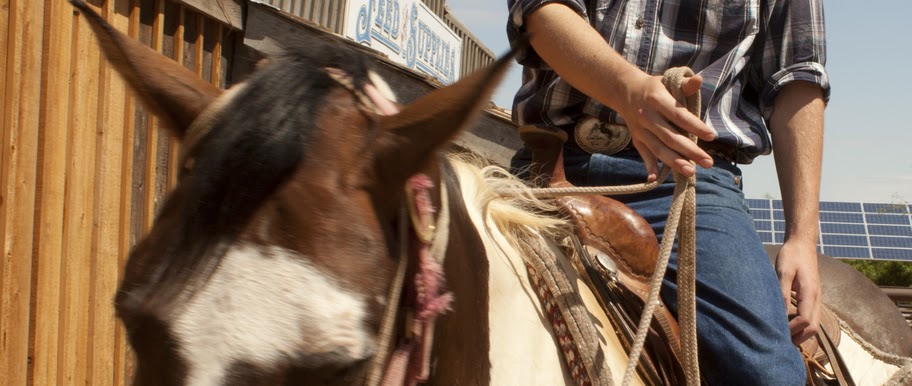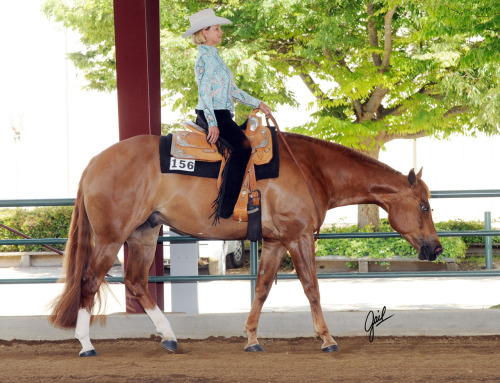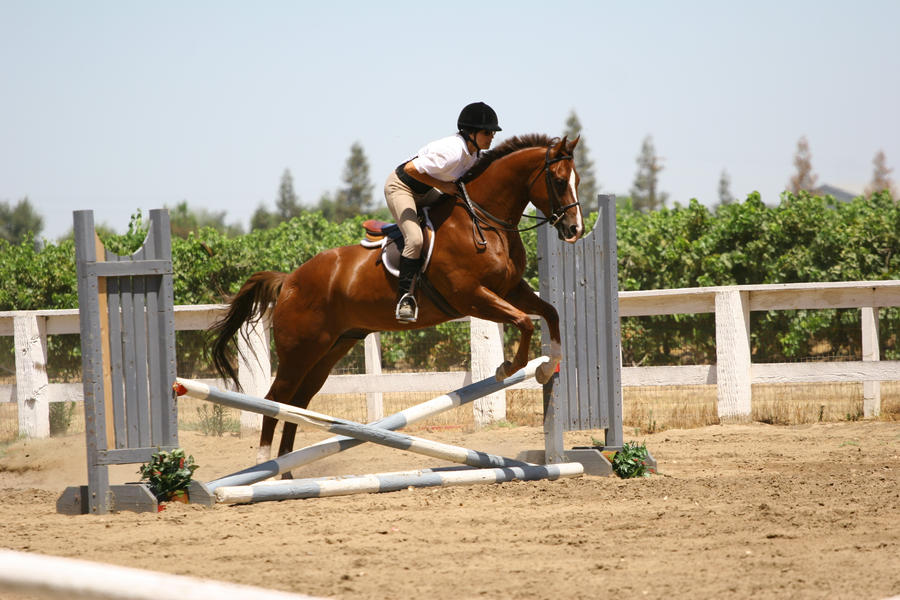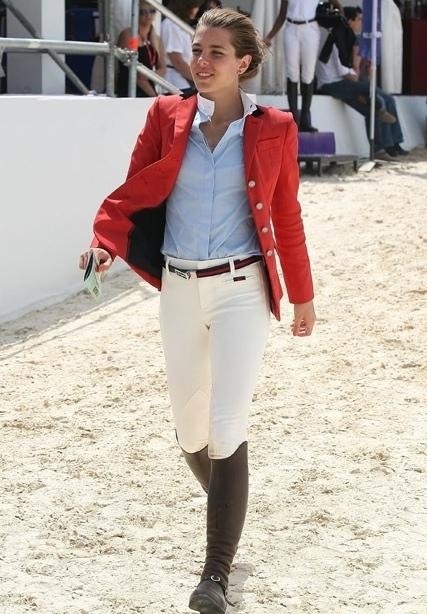 |
| Western Saddle |
First, there's a difference in tack. The western saddle is larger and heavier than the English saddle. It's designed to spread the weight of the rider over a larger area of the horses back, making it more comfortable for longer days on the trails, doing cattle work and etc. The english saddle is smaller and lighter and designed to give the rider a closer contact with the horse's back. With both the english and the western saddle, different designs are available to accomodate certain styles, sports and disciplines such as Dressage, Barrel Racing, Jumping, reining and etc.
 |
| (Source) |
As far as riding goes, the main difference between english and western riding is that in english riding, the rider takes a direct contact with the horse's mouth using the reins and uses the reins as part of the "aids" (along with the seat and the leg) for speed and direction. Most western riding horses are ridden on little or no contact and the rider uses his seat, his weight and neck-reining to give aids to the horse.
 |
| (source) |
 |
| (Source) |
 |
| (source) |
Here are a few interesting parts of an article I found here. I will write in bold when I make a comment. :)
"Western riding is more passive and emphasizes lower regular contact between the rider and the horse. One of the biggest challenges for me as an English rider is that I'm used to riding with very low contact on my reins and with my legs. English emphasizes constant contact with the horse while Western emphasizes that riding should be relaxed and communication between the rider and the horse should be subtle and happen as needed.
On the other hand, Western contact can look extreme when it does happen. My wife regularly complains about how Western riders "kick" their horses when changing gaits. For an English rider who is used to maintaining contact in a gait, getting a gait change can be as simple as giving a light squeeze. But a Western rider isn't keeping as much contact, so asking for a gait change requires more motion - a kick. Western horses are used to this. English horses - not so much. I personally kind of agree/disagree with this. When I go for contact with my own horse, I don't just kick him until he does it. Red knows his cues for a walk, trot, canter/jog and gallop. For instance, if I want a walk, I keep my reins loose and down. I cluck my tongue and he walks. If I want a trot, I kick lightly and tighten the reins ever so slightly and "kiss" more, he responds well to pats on his butt or neck. When I want a canter or jog, I kick him lightly with the outside leg, when I want a gallop, I do almost the same as the canter but slightly harder. I'm not one of these:
| Okay, I love barrel racing but whata kick. |
For a rider, this necessitates two big changes when switching disciplines. One is that English riding emphasizes steady rein contact with the bit, which is generally not a problem when using an o-ring snaffle. But in Western, this pressure would translate through the shank into a larger and more irritating constant pressure in the horse's mouth. As such, Western riders use much less rein contact.
The other is that in English you're trained to keep your hands up higher than you are in Western. The philosophy behind hand position is actually the same in both disciplines - there should be a straight line between the point of contact with the bit and your hands. But in Western, that point of contact is lower (see above about the shank) and that means your hands must be lower as well. In relaxed riding, I would frequently rest my hands on my horse's withers. When riding more aggressively, I would keep my reins forward and directly on top of her neck.
Leg communication is much more important with Western. Remember when I said that Western riders don't maintain as much contact with their legs? While generally true, a good Western horse can be controlled almost exclusively through leg pressure and body position. By trading off having constant contact with a horse, a good Western rider can communicate using irregular and focused contact. A good Western rider can move a good horse left and right by giving pressure cues from their legs while keeping a completely slack rein. The cutting and reining events demonstrate this skill. Red works off of mostly leg pressure, he knows his cues, I don't kick like crazy, I tighten my legs up and he knows what I mean when I do it.
A whole new style of riding emerges. A good Western horse can be ridden exclusively with one hand using leg pressure to keep control at all times. Why? Because your other hand is too busy throwing a rope, shooting a gun, or doing all those other things that cowboys needed to do while riding on the range. I was frequently told that a good rider should never ride with two hands on their reins unless they were schooling a young horse. (I also frequently ignored this rule since I never showed in judged events and my mare was a nutty barrel horse.) I kinda disagree with the two hands on the reins as well, as I sometimes have to open rein, rarely, but sometimes I do.
_______________________
The horses are different as well, most of the time, Western riders tend to stick with stockier horses such as Paints, Quarter Horses, Appaloosas and etc. English riders tend to go with Thoroughbred types, although sometimes a Quarter horse is meant to be an English horse and a TB is meant to be a Western horse.
 |
| Jumping Quarter Horse (source) |
Here are the gait differences.
- Walk: very similar for both English and Western.
- Trot/Jog: A jog is very smooth, relaxed, and slightly faster than a walk. The jog is useful for following herds of cattle. Riders sit a jog, and do not post. In English riding the trot is posted unless a sitting trot is required in the show ring.
- Canter/Lope: The Western lope is a slow relaxed canter. English riders will learn that the canter can be very elevated, extended, or collected with many variations in speed depending on the specific discipline or style.
 |
| From Tumblr |
 |
| (source) |
The most distinctive element of western riding is the traditional
western hat. A comfortable shirt, jeans and western-style boots
complete the look. Many Western riders opt to wear sporty looking
helmets, especially when showing. English riders wear a traditional style 'hunt cap' or helmet. A fitted jacket, shirt, jodhpurs or breeches and jodhpur boots or tall boots complete the English rider's attire. When casually riding, most English riders tend to stick with breeches, boots and occasionally even a t-shirt, while Western riders will do the same.
The Basics of What You’ll Need to Know:
Western riders will learn how to neck rein. English riders will ride with a rein in each hand and post the trot.
There are many different skills you will need to learn if you plan to
compete. You'll need to learn to braid or band a mane, pull a tail, and
other grooming details depending on what you are competing in.
 |
| From Tumblr, Beachcomber Photography 2009 |
English and Western Disciplines:
After learning the basics of either style, there are many sports you can try. These are just a few:
Western
English
Western
- Team penning
- Cutting
- Reining
- Speed Games
- Trail Classes
- Pleasure and Equitation Classes
- Roping
- Trail Riding
 |
| Team Penning (Source) |
English
- Dressage
- English or English Country Pleasure
- Jumping
- Hunting
- Mounted Games
- Polo
- Hunter Pace
 |
| Hunter (source) |
Sports In Which You Could Ride Either Or English or Western Style:
Some sports allow for either style of riding.
- Trail Riding
- Endurance racing
- Competitive Trail Riding
- Competitive Mounted Orienteering
- Some local open shows have mixed English/Western classes
 |
| Here you can see English and Western riders. (source) |

A good english horse can be controled through leg and seat only as well.
ReplyDeleteI think any horse should be able to, no matter what discipline. It's a matter of good training.
Delete